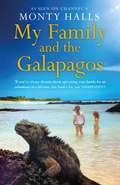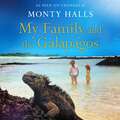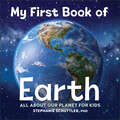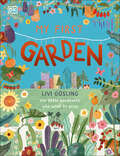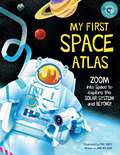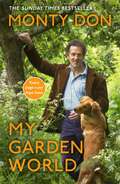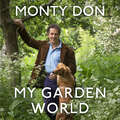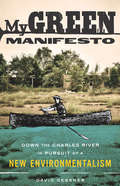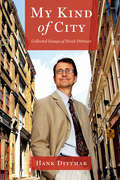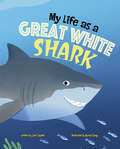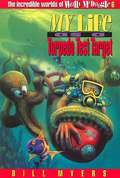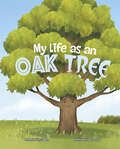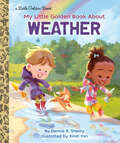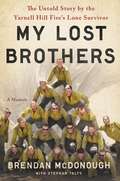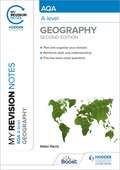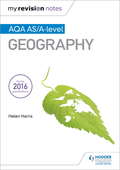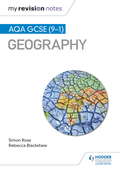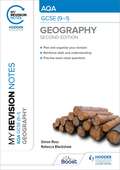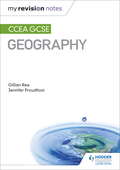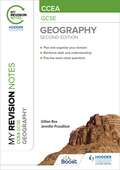- Table View
- List View
My Family and the Galapagos
by Monty HallsThe Galapagos Islands have captured hearts and captivated imaginations for centuries. Such is their ecological importance that in 1978 the archipelago was declared the first ever World Heritage Site, a testament to our collective desire to preserve the magic and diversity that inspired Darwin. Monty Halls first visited the islands almost twenty years ago and his immediate fascination with their wild beauty would go on to shape the rest of his life.As an explorer, marine biologist, ex-Royal Marine and now President of the Galapagos Conservation Trust, Monty is a passionate advocate for those fighting to save the Galapagos. In 2017, he and his dedicated research team - his wife, Tam, and their two young daughters, Molly and Isla - moved to Santa Cruz to experience just what life is like in the world's most spectacular tourist destination. As weeks turned into months, the Halls family were in turn spellbound by the beauty of the islands and heartbroken by the devastation that humans are inflicting upon them. One stint there was never going to be enough, and just two years later they found themselves heading back, this time staying on one of the remotest and most challenging islands, diving into the culture of the Galapagos and the desperately needed conservation work taking place there.Written with warmth, humour, and authority, My Family and the Galapagos follows Monty and his family as they navigate life on the most important archipelago on the planet and strive to preserve it for generations to come.
My Family and the Galapagos
by Monty HallsThe Galapagos Islands have captured hearts and captivated imaginations for centuries. Such is their ecological importance that in 1978 the archipelago was declared the first ever World Heritage Site, a testament to our collective desire to preserve the magic and diversity that inspired Darwin. Monty Halls first visited the islands almost twenty years ago and his immediate fascination with their wild beauty would go on to shape the rest of his life.As an explorer, marine biologist, ex-Royal Marine and now President of the Galapagos Conservation Trust, Monty is a passionate advocate for those fighting to save the Galapagos. In 2017, he and his dedicated research team - his wife, Tam, and their two young daughters, Molly and Isla - moved to Santa Cruz to experience just what life is like in the world's most spectacular tourist destination. As weeks turned into months, the Halls family were in turn spellbound by the beauty of the islands and heartbroken by the devastation that humans are inflicting upon them. One stint there was never going to be enough, and just two years later they found themselves heading back, this time staying on one of the remotest and most challenging islands, diving into the culture of the Galapagos and the desperately needed conservation work taking place there.Written with warmth, humour, and authority, My Family and the Galapagos follows Monty and his family as they navigate life on the most important archipelago on the planet and strive to preserve it for generations to come.
My Family and the Galapagos
by Monty HallsThe Galapagos Islands have captured hearts and captivated imaginations for centuries. Such is their ecological importance that in 1978 the archipelago was declared the first ever World Heritage Site, a testament to our collective desire to preserve the magic and diversity that inspired Darwin. Monty Halls first visited the islands almost twenty years ago and his immediate fascination with their wild beauty would go on to shape the rest of his life.As an explorer, marine biologist, ex-Royal Marine and now President of the Galapagos Conservation Trust, Monty is a passionate advocate for those fighting to save the Galapagos. In 2017, he and his dedicated research team - his wife, Tam, and their two young daughters, Molly and Isla - moved to Santa Cruz to experience just what life is like in the world's most spectacular tourist destination. As weeks turned into months, the Halls family were in turn spellbound by the beauty of the islands and heartbroken by the devastation that humans are inflicting upon them. One stint there was never going to be enough, and just two years later they found themselves heading back, this time staying on one of the remotest and most challenging islands, diving into the culture of the Galapagos and the desperately needed conservation work taking place there.Written with warmth, humour, and authority, My Family and the Galapagos follows Monty and his family as they navigate life on the most important archipelago on the planet and strive to preserve it for generations to come.
My First Book of Earth: All About Our Planet for Kids (My First Book of)
by Stephanie Manka SchuttlerSee how much there is to discover with this Earth science adventure for kids 3-5. From the same series as the popular My First Book of Planets!From the clouds way up above us to the liquid core miles beneath our feet, there are so many amazing things about Earth. See what makes our home planet so special with this introduction to land, sea, and sky for preschool and kindergarten kids. With My First Book of Earth, they'll explore the different continents, how weather works, the important jobs of trees and plants, and so much more!Awesome images—Colorful photos and accurate illustrations show off unbelievable scenery like volcanoes, canyons, and the moon.Why does that happen? —This nonfiction science book for kids explains how rocks are formed, what makes the sun go down at night, and why gravity affects the oceans.Fascinating Earth facts—Did you know that there are mountains underwater? Or that the tallest tree is almost as tall as 19 houses stacked on top of each other? Find trivia like this and more in this amazing Earth book for kids.Pick up this ultimate book of planet Earth and encourage curious kids to read, learn, and explore.
My First Garden: For Little Gardeners Who Want to Grow (My First Series)
by Livi GoslingThis beautifully illustrated guide is the perfect gardening book for kids who want to plant fruit and vegetables, create mini farms from plants, and go on wildflower missions. Dive into this children&’s guide to growing plants, from vegetables to wildflowers, for little gardeners with green fingers. With clear step-by-step instructions on how to get seeds, plant them, and help them grow, this book will help kids to get started with their very first gardening projects. Children aged 5-7 will love getting stuck into gardening projects with My First Garden! Passionate gardener Livi Gosling has advice on creating places for plants to live in your home, scavenging from the recycling to create a vegetable kingdom, and adding a splash of color to grey city streets with your own wildflower seed mix. This first gardening book for children features: - Beautiful illustrations combined with a fun approach to gardening for lovers of the ever-growing nature trend.- The basics for growing different plants for children, from gorgeous flowers to delicious fruit and vegetables.- Advice and projects inclusive of all homes, including rented flats - you don&’t need a huge gardening space to get gardening!- A strong eco-message, with info about what seasonality is, planting for pollinators, reusing and recycling things in your garden, and encouraging rewilding of your area.No matter how tiny your space, you can be a gardener! Featuring plenty of inspiration and helpful tips, this gardening book makes a lovely gift from parents and grandparents who want to encourage hands-on hobbies, and is a great eco activity for kids to get outdoors and away from a screen.
My First Space Atlas: Zoom into Space to Explore the Solar System and Beyond (My First Atlas)
by Jane WilsherLand on the Moon, visit the International Space Station, take a space walk, and tour the planets in this fact-filled guide to the galaxy! Watch out for space junk and black holes! Filled with bright, bold, and scientifically accurate illustrations, fascinating inLayoution, and an interactive "Spot It" game throughout the book, My First Space Atlas will thrill aspiring astronauts and space explorers. FILLED WITH FACTS: Dozens of space facts for curious young space explorers. BOLD ILLUSTRATIONS: Astronauts, rockets, rovers, planets, and more are depicted in bright, colorful illustrations that accurately represent their key features and characteristics. EXPERT AUTHORITY: Created in collaboration with astrophysicist Dr Ben Maughan, My First Space Atlas &“space scientist approved&” and includes all the latest expert inLayoution. READ ALONE OR READ ALOUD: Independent readers will pore over the hundreds of fascinating facts about space, and emerging readers will love learning along with their favorite grown-up. PLAY THE "SPOT IT" GAME: "Can you find the camera on the Moon buggy?", "How many planets are in the Solar System?" There are clues and pictures on every spread to find out all sorts of space inLayoution.
My Garden World: the Sunday Times bestseller
by Monty DonTHE SUNDAY TIMES BESTSELLER & BEST GARDENING BOOKS OF 2020 - Sunday Times'Every page a joy' NIGEL SLATER'From a very early age I loved the countryside as much as any garden and was fascinated by the life that I saw all around me from trees, wildflowers, birds, insects and mammals. In a sense this book has been over sixty years in gestation. I have kept notebooks and journals ever since I could write and I have drawn upon these as well as the events of the past year.'Spend a year with Monty Don. My Garden World is a celebration of every living creature and the natural world that we all share. Recent times have given us the enforced opportunity to learn more about the fascinating natural world around us. Whether you live in the countryside or the town, Monty's observations and insights are relevant to each and every one of us. My Garden World is Monty Don's personal journey through the natural year, month by month, season by season, observed from the immediate world around him.'Wildlife is not something that we watch happening in remote and exotic parts of the world on our screens, but right here in our own back yards and the more that we encourage it and learn to live with it, the more rewarding it becomes.If, in our own modest back yards, we can help preserve and treasure our natural world then we will make the world a better place -- not just for ourselves but for every living creature.'
My Garden World: the Sunday Times bestseller
by Monty DonTHE SUNDAY TIMES BESTSELLER - BEST GARDENING BOOKS OF 2020 - Sunday Times, Times 'Every page a joy.' Nigel Slater'From a very early age I loved the countryside as much as any garden and was fascinated by the life that I saw all around me from trees, wildflowers, birds, insects and mammals. In a sense this book has been over sixty years in gestation. I have kept notebooks and journals ever since I could write and I have drawn upon these as well as the events of the past year.'My Garden Worldby Monty Don is a celebration of every living creature that we all share. This year has given us the enforced opportunity to learn more about the fascinating natural world around us. Whether you live in the countryside or the town, Monty's observations and insights are relevant to each and every one of us. My Garden Worldis Monty Don's personal journey through the natural year, month by month, season by season, observed from the immediate world around him. 'Wildlife is not something that we watch happening in remote and exotic parts of the world on our screens, but right here in our own back yards and the more that we encourage it and learn to live with it, the more rewarding it becomes.If, in our own modest back yards, we can help preserve and treasure our natural world then we will make the world a better place -- not just for ourselves but for every living creature.'
My Garden World: the Sunday Times bestseller
by Monty Don'From a very early age I loved the countryside as much as any garden and was fascinated by the life that I saw all around me from trees, wildflowers, birds, insects and mammals. In a sense this book has been over sixty years in gestation. I have kept notebooks and journals ever since I could write and I have drawn upon these as well as the events of the past year.'A year at home in the country with Monty Don - the UK's favourite gardener, dog owner, writer and broadcaster - on a personal journey through the natural year, season by season, month by month.My Garden World by Monty Don is a celebration of every living creature that we all share. This year has given us the enforced opportunity to learn more about the fascinating natural world around us. Whether you live in the countryside or the town, Monty's observations and insights are relevant to each and every one of us. My Garden World is Monty Don's personal journey through the natural year, month by month, season by season, observed from the immediate world around him. 'Wildlife is not something that we watch happening in remote and exotic parts of the world on our screens, but right here in our own back yards and the more that we encourage it and learn to live with it, the more rewarding it becomes.If, in our own modest back yards, we can help preserve and treasure our natural world then we will make the world a better place -- not just for ourselves but for every living creature.'(P)2020 Hodder & Stoughton Limited
My Green Manifesto: Down the Charles River in Pursuit of a New Environmentalism
by David GessnerAll environmentalism is local: “A wonderfully readable book” about saving the planet by focusing first on our own habitats (The Boston Globe).Though environmental awareness is on the rise, our march toward ecological collapse continues. What was once a movement based primarily on land preservation, endangered species, and policy reform is now a fractured mess of back-to-the-landers, capitalist “green lifestyle” vendors, technology worshipers, and countless special interest groups.Inspired by a rough-and-tumble journey across country and down river, David Gessner, a John Burroughs Award winner, makes the case for a new environmentalism. In a frank, funny, and incisive call to arms that spans from the Cape Wind Project to the Monkey Wrench Gang, he considers why we do or do not fight to protect and restore wilderness, and reminds us why it’s time to join the fray.Known as an environmental advocate “reminiscent of Edward Abbey” (Library Journal), Gessner rebels against this fragmented environmentalism and holier-than-thou posturing. He also suggests that global problems, though real, are disempowering. While introducing us to lovable, stubborn Dan Driscoll, “a regular guy fighting a local fight for a limited wilderness,” he argues for a movement focused on local issues and grounded in a more basic, more holistic—and ultimately more effective—defense of home.“Funny and inspiring.” —Publishers Weekly (starred review)
My Kind of City: Collected Essays of Hank Dittmar
by Hank Dittmar"Hank lived by the credo, ‘first listen, then design'.”—Scott Bernstein, Founder and Chief Strategy + Innovation Officer, Center for Neighborhood Technology Hank Dittmar was a globally recognized urban planner, advocate, and policy advisor. He wrote extensively on a wide range of topics, including architectural criticism, community planning, and transportation policy over his long and storied career. In My Kind of City, Dittmar has organized his selected writings into ten sections with original introductions. His observations range on scale from local ("My Favorite Street: Seven Dials, Covent Garden, London”) to national ("Post Truth Architecture in the Age of Trump”) and global ("Architects are Critical to Adapting our Cities to Climate Change”). Andrés Duany writes of Hank in the book foreword, "He has continued to search for ways to engage place, community and history in order to avoid the tempting formalism of plans.” The range of topics covered in My Kind of City reflects the breadth of Dittmar's experience in working for better cities for people. Common themes emerge in the engaging prose including Dittmar's belief that improving our cities should not be left to the "experts”; his appreciation for the beautiful and the messy; and his rare combination of deep expertise and modesty. As Lynn Richards, CEO of Congress for the New Urbanism expresses in the preface, "Hank's writing is smart without being elitist, witty and poetic, succinct and often surprising.”My Kind of City captures a visionary planner's spirit, eye for beauty, and love for the places where we live.
My Life as a Great White Shark (My Life Cycle)
by John SazaklisHi, there! I'm a great white shark. Don't let my sharp teeth scare you off. I started life much smaller, just like you! Learn more about my life cycle and how I went from a tiny little shark pup to the ocean's top predator.
My Life as a Torpedo Test Target (The Incredible Worlds of Wally McDoogle #6)
by Bill MyersForty feet underwater with a million dollars of gold in reach, Wally McDoogle only has to overcome: Sea monsters... Hostile pirates... A ghost ship... And, of course, the world famous McDoogle klutziness. Will he be able to avoid catastrophe and chaos? Probably not. Just as our hero goes for the gold, he finds himself on a wild ride atop a misguided torpedo and realizes the true cost of greed.
My Life as an Oak Tree (My Life Cycle)
by John SazaklisHi, there! I'm an oak tree. You might see me everywhere, but have you ever stopped to think about how I got there? Learn more about my life cycle and how I went from a tiny little acorn to a big, beautiful tree.
My Little Golden Book About Weather (Little Golden Book)
by Dennis R. ShealyThis nonfiction Little Golden Book is about a common preschool subject--the weather!It's always perfect weather for reading! This nonfiction Little Golden Book introduces preschoolers to more than just rain, wind, and snow. Through engaging artwork and text, they'll learn about how the sun's energy causes daily weather conditions. They'll also learn about the four yearly seasons, how clouds are formed, what a meteorologist is, and so much more. It's a great "first book" to inspire young minds!
My Lost Brothers: The Untold Story by the Yarnell Hill Fire's Lone Survivor
by Stephan Talty Brendan McdonoughA gripping first-person account by the sole survivor of Arizona's disastrous 2013 Yarnell Hill Fire, which took the lives of 19 "hotshots"--firefighters trained specifically to battle wildfires.Brendan McDonough was on the verge of becoming a hopeless, inveterate heroin addict when he, for the sake of his young daughter, decided to turn his life around. He enlisted in the Granite Mountain Hotshots, a team of elite firefighters based in Prescott, Arizona. Their leader, Eric Marsh, was in a desperate crunch after four hotshots left the unit, and perhaps seeing a glimmer of promise in the skinny would-be recruit, he took a chance on the unlikely McDonough, and the chance paid off. Despite the crew's skepticism, and thanks in large part to Marsh's firm but loving encouragement, McDonough unlocked a latent drive and dedication, going on to successfully battle a number of blazes and eventually win the confidence of the men he came to call his brothers.Then, on June 30, 2013, while McDonough--"Donut" as he'd been dubbed by his team--served as lookout, they confronted a freak, 3,000-degree inferno in nearby Yarnell, Arizona. The relentless firestorm ultimately trapped his hotshot brothers, tragically killing all 19 of them within minutes. Nationwide, it was the greatest loss of firefighter lives since the 9/11 attacks. My Lost Brothers is a gripping memoir that traces McDonough's story of finding his way out of the dead end of drugs, finding his purpose among the Granite Mountain Hotshots, and the minute-by-minute account of the fateful day he lost the very men who had saved him. A harrowing and redemptive story of resilience in the face of tragedy, My Lost Brothers is also a powerful reminder of the heroism of the people who put themselves in harm's way to protect us every day.
My Revision Notes: AQA A-level Geography: Second Edition
by Helen HarrisTarget exam success with My Revision Notes. Our updated approach to revisionwill help students learn, practise and apply their skills and understanding. Coverage ofkey content is combined with practical study tips and effective revision strategiesto create a guide that can be relied on to build both knowledge and confidence.My Revision Notes: AQA A-level Geography will help students:- Develop subject knowledge by making links between topics for more in-depth exam answers- Plan and manage revision with our topic-by-topic planner and exam breakdown introduction- Practise and apply skills and knowledge with Exam-style questions and frequent check yourunderstanding questions, and answer guidance online- Build quick recall with bullet- pointed summaries at the end of each chapter- Understand key terms for the exam with user-friendly definitions and a glossary- Avoid common mistakes and enhance exam answers with Examiner tips- Improve subject-specific skills with an Exam skills checkbox at the end of each chapter
My Revision Notes: AQA A-level Geography: Second Edition
by Helen HarrisTarget exam success with My Revision Notes. Our updated approach to revisionwill help students learn, practise and apply their skills and understanding. Coverage ofkey content is combined with practical study tips and effective revision strategiesto create a guide that can be relied on to build both knowledge and confidence.My Revision Notes: AQA A-level Geography will help students:- Develop subject knowledge by making links between topics for more in-depth exam answers- Plan and manage revision with our topic-by-topic planner and exam breakdown introduction- Practise and apply skills and knowledge with Exam-style questions and frequent check yourunderstanding questions, and answer guidance online- Build quick recall with bullet- pointed summaries at the end of each chapter- Understand key terms for the exam with user-friendly definitions and a glossary- Avoid common mistakes and enhance exam answers with Examiner tips- Improve subject-specific skills with an Exam skills checkbox at the end of each chapter
My Revision Notes: AQA AS/A-level Geography
by Helen HarrisTarget success in AQA AS/A-level Geography with this proven formula for effective, structured revision; key content coverage is combined with exam-style tasks and practical tips to create a revision guide that students can rely on to review, strengthen and test their knowledge.With My Revision Notes every student can:- Plan and manage a successful revision programme using the topic-by-topic planner- Consolidate subject knowledge by working through clear and focused content coverage- Test understanding and identify areas for improvement with regular 'Now Test Yourself' tasks and answers- Enhance exam responses using relevant case studies for each topic- Improve exam technique through practice questions, expert tips and examples of typical mistakes to avoid
My Revision Notes: AQA GCSE (91) Geography
by Simon Ross Rebecca BlackshawExam Board: AQALevel: GCSESubject: GeographyFirst Teaching: September 2016First Exam: Summer 2018Target success in AQA GCSE (9-1) Geography with this proven formula for effective, structured revision; key content coverage is combined with exam-style tasks and practical tips to create a revision guide that students can rely on to review, strengthen and test their knowledge.With My Revision Notes every student can:- Plan and manage a successful revision programme using the topic-by-topic planner- Enjoy an active approach to revision with clear topic coverage and related 'Now Test Yourself' tasks and practical revision activities- Improve exam technique through exam tips and formal exam-style questions- Monitor their knowledge and progress using the answers provided for each activity and exam-style question- Develop geographical understanding and enhance exam responses with case study material and event/place examples
My Revision Notes: AQA GCSE (9–1) Geography Second Edition
by Simon Ross Rebecca BlackshawSet your students on track to achieve the best grade possible with My Revision Notes. Our updated approach to revision will help students learn, practise and apply their skills and understanding. Coverage of key content is combined with practical study tips and effective revision strategies to create a guide that can be relied on to build both knowledge and confidence.My Revision Notes: AQA GCSE (9-1) Geography will help students:- Develop subject knowledge by making links between topics for more in-depth exam answers- Plan and manage revision with our topic-by-topic planner and exam breakdown introduction- Practise and apply skills and knowledge with Exam-style questions and frequent check yourunderstanding questions, and answer guidance online- Build quick recall with bullet- pointed summaries at the end of each chapter- Understand key terms for the exam with user-friendly definitions and a glossary- Avoid common mistakes and enhance exam answers with Examiner tips- Improve subject-specific skills with an Exam skills checkbox at the end of each chapter
My Revision Notes: AQA GCSE (9–1) Geography Second Edition
by Simon Ross Rebecca BlackshawSet your students on track to achieve the best grade possible with My Revision Notes. Our updated approach to revision will help students learn, practise and apply their skills and understanding. Coverage of key content is combined with practical study tips and effective revision strategies to create a guide that can be relied on to build both knowledge and confidence.My Revision Notes: AQA GCSE (9-1) Geography will help students:- Develop subject knowledge by making links between topics for more in-depth exam answers- Plan and manage revision with our topic-by-topic planner and exam breakdown introduction- Practise and apply skills and knowledge with Exam-style questions and frequent check yourunderstanding questions, and answer guidance online- Build quick recall with bullet- pointed summaries at the end of each chapter- Understand key terms for the exam with user-friendly definitions and a glossary- Avoid common mistakes and enhance exam answers with Examiner tips- Improve subject-specific skills with an Exam skills checkbox at the end of each chapter
My Revision Notes: CCEA GCSE Geography (Geography For Ccea Ser.)
by Jennifer Proudfoot Gillian ReaTarget success in CCEA GCSE Geography with this proven formula for effective, structured revision; key content coverage is combined with exam-style tasks and practical tips to create a revision guide that students can rely on to review, strengthen and test their knowledge.With My Revision Notes every student can:- Plan and manage a successful revision programme using the topic-by-topic planner- Enjoy an active approach to revision with clear topic coverage and related 'Now Test Yourself' tasks and practical revision activities- Improve exam technique through exam tips and formal exam-style questions- Monitor their knowledge and progress using the answers provided for each 'Now Test Yourself' activity and exam-style question- Develop geographical understanding and enhance exam responses with case study material
My Revision Notes: CCEA GCSE Geography Second Edition
by Jennifer Proudfoot Gillian ReaSet your students on track to achieve the best grade possible with My Revision Notes. Our updated approach to revision will help students learn, practise and apply their skills and understanding. Coverage of key content is combined with practical study tips and effective revision strategies to create a guide that can be relied on to build both knowledge and confidence. My Revision Notes: CCEA GCSE (9-1) Geography will help students: - Plan and manage revision with our topic-by-topic planner and exam breakdown introduction - Practise and apply skills and knowledge with Exam-style questions and frequent check your understanding questions, and answer guidance online - Build quick recall with bullet- pointed summaries at the end of each chapter - Understand key terms for the exam with user-friendly definitions and a glossary - Avoid common mistakes and enhance exam answers with Examiner tips - Improve subject-specific skills with an Exam skills checkbox at the end of each chapter
My Revision Notes: CCEA GCSE Geography Second Edition
by Jennifer Proudfoot Gillian ReaSet your students on track to achieve the best grade possible with My Revision Notes. Our updated approach to revision will help students learn, practise and apply their skills and understanding. Coverage of key content is combined with practical study tips and effective revision strategies to create a guide that can be relied on to build both knowledge and confidence. My Revision Notes: CCEA GCSE (9-1) Geography will help students: - Plan and manage revision with our topic-by-topic planner and exam breakdown introduction - Practise and apply skills and knowledge with Exam-style questions and frequent check your understanding questions, and answer guidance online - Build quick recall with bullet- pointed summaries at the end of each chapter - Understand key terms for the exam with user-friendly definitions and a glossary - Avoid common mistakes and enhance exam answers with Examiner tips - Improve subject-specific skills with an Exam skills checkbox at the end of each chapter
